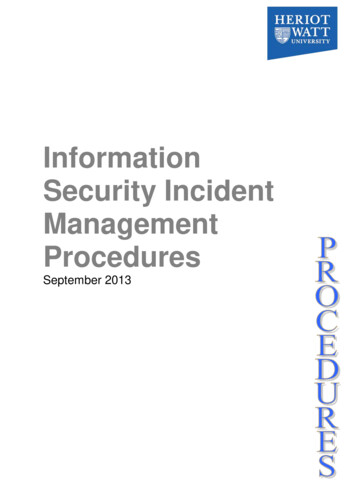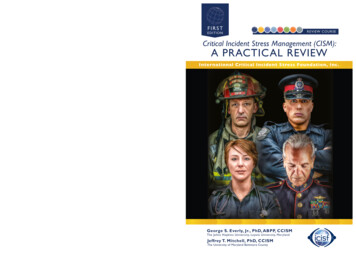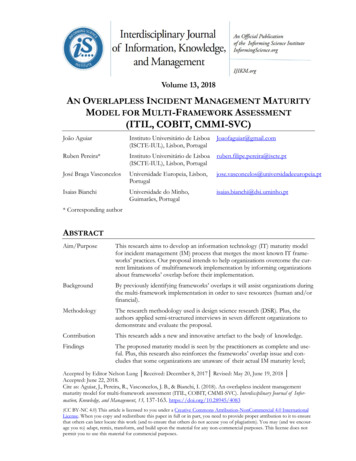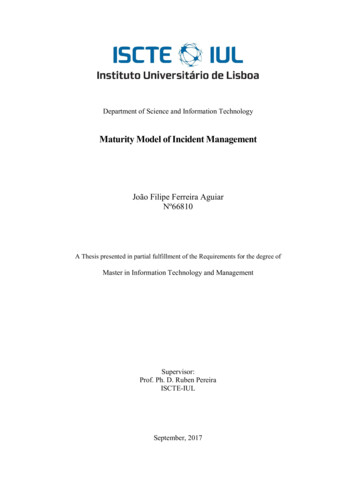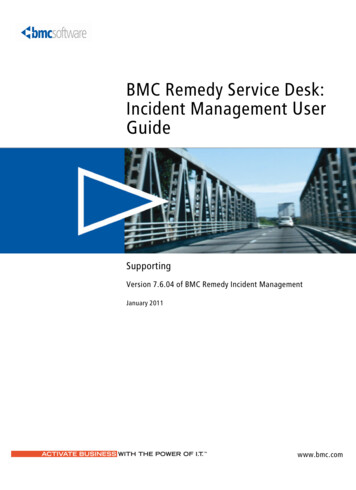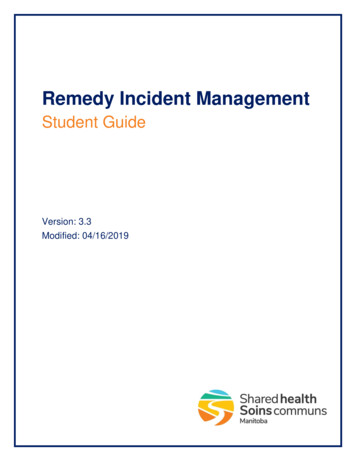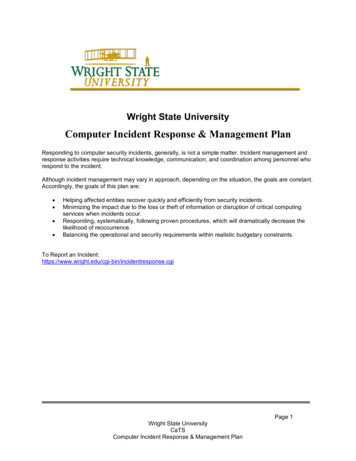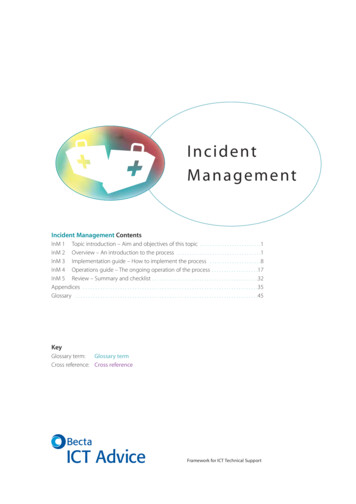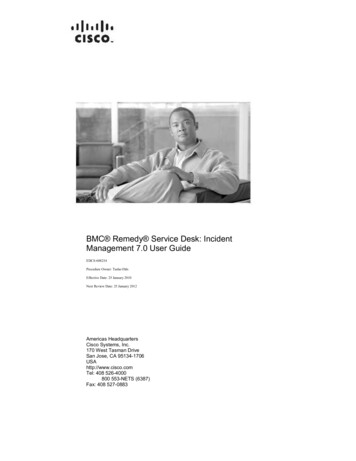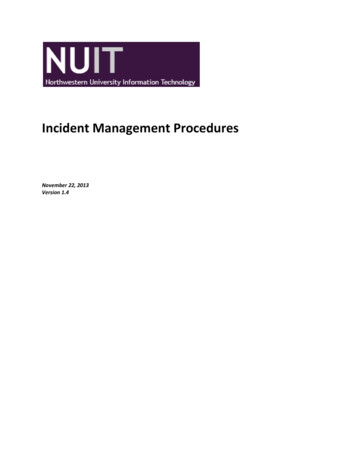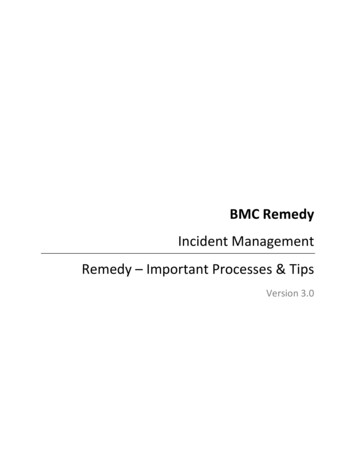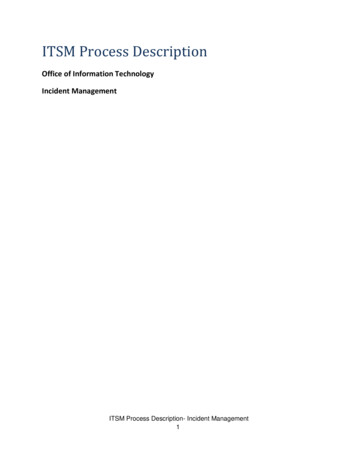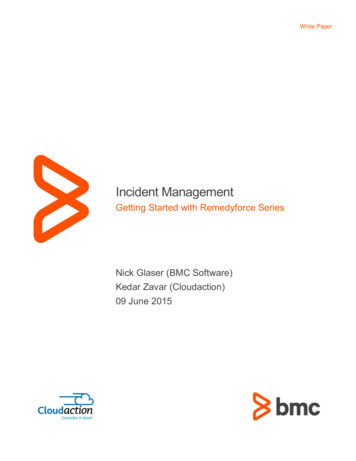
Transcription
White PaperIncident ManagementGetting Started with Remedyforce SeriesNick Glaser (BMC Software)Kedar Zavar (Cloudaction)09 June 2015
Incident ManagementGetting Started with Remedyforce SeriesWelcome to the “Getting Started with BMC Remedyforce” SeriesToday’s IT departments must drive business growth and innovation, while coping with less resources and increasing complexity. To do this, theyrequire an IT Service Management solution that provides best practices while minimizing costs. BMC Remedyforce is built on Salesforce—the world'smost widely used cloud platform—to deliver complete IT service management functionality with the secure social, mobile, and collaborative capabilitiesusers expect.With the “Getting Started with Remedyforce” white paper series, our aim is to help you leverage BMC Remedyforce to improve the effectiveness andefficiency of your ITSM operations. Each paper addresses a specific area of interest and provides you with conceptual, functional and technical bestpractices to make configuration decisions and take action to gain value from your BMC Remedyforce investment.Incident ManagementA basic function of almost every service delivery organization is the identification and remediation of technical challenges experienced by end users.Addressing these day-to-day requirements is the mainstay of most service delivery organizations. In ITIL terminology, this operational activity is knownas Incident Management.Incident: An incident is an unplanned interruption to an IT Service or reduction in the quality of an IT service. (Source: ITIL, v3)The key goal of Incident management is to restore normal service operation as quickly as possible and to minimize the adverse impact on businessoperations.What this means in very real terms is that any organization looking to perform Incident Management must be primarily concerned with ensuringcustomers who are having difficulty consuming the services provided by the service delivery organization are returned to a working state quickly andefficiently. Service delivery providers must be organized in such a way that they can log incident tickets, resolve them quickly and, when necessary,escalate these tickets to experts in other parts of the IT organization when needed. Additionally, it is expected that IT service providers will utilize bothtechnology and process to identify significant service-threatening events occurring in their environment and take pro-active steps to mitigate the impactof these events on the end-user community before they are even noticed by users and reported as incidents.Planning and implementation of an effective and efficient Incident Management process is one of the most fundamental and critical exercises for an ITservice provider.Key Components in BMC Remedyforce:The following are the key components in BMC Remedyforce that support Incident Management: Record PlanningStatusesTemplatesWorkflow Automation and RulesCommunication ManagementPrioritizationCategorizationIn addition to restoring service operations as quickly as possible additional value can be drawn from the Incident Management process. When taken incontext with the other facets of the ITIL methodology there is significant value to the business including the ability to detect incidents occurring in the ITenvironment and respond in an efficient manner, resulting in higher availability of the service; identifying potential service improvements garnered fromPAGE 1 OF 14Copyright BMC Software, Inc. 2015
Incident ManagementGetting Started with Remedyforce Seriescontact between the business and the service delivery operations staff; realizing service or training requirements and, perhaps most importantly,aligning IT activities to real-time business priorities.Alignability Process Model (APM)If you are just getting started with Incident Management, and especially if you are planning to leverage BMC’s out-of-the-box capabilities, BMCRemedyforce provides a best practices framework via the Alignability Process Mode (APM). The APM describes a set of predefined processes for thedelivery and support of services and illustrates how ITIL processes map work to instructions performed in BMC Remedyforce. The model was built toprovide an easy-to-use interface that allows for quick access to detailed information regarding the Incident Management process.Figure 1 – Incident Management Process ModelFor more information about BMC Remedyforce’s Alignability Process Model for Incident Management, you can log into BMC Remedyforce andnavigate to the Alignability Process Model on the sidebar. If you do not see the sidebar, you can view it by selecting ALT S. The sidebar will thenappear.Primary Activities - Incident Management Process:Please note the flow could be different based on processes but this covers primary activities. Escalations to problem or change request or majorincident is not covered in this diagram.PAGE 2 OF 14Copyright BMC Software, Inc. 2015
Incident ManagementGetting Started with Remedyforce t ClosureClosureClassificationUpdating customersCommunicationUpdates*This could be applied through outthe processFigure 2 - Primary Activities - Incident ManagementIncident Management – Best PracticesIncident Management is a broad topic which can take many shapes even when following the ITIL framework. There are many strategies that can beused to implement an incident management system therefore it is a more profitable to review the common elements of these strategies that allow themto be successful and how those elements can be addressed within the Remedyforce application.It is strongly recommended that all the elements below be reviewed on a regular basis to ensure their relevance to your organizations goals and theirviability in your service delivery environment. Regular review of these elements should become a part of your organizational lifestyle and methodology.To this end, internal committees should be developed and assigned to these elements with the mission of regular assessment and enhancement to theexisting configuration elements where useful and necessary.Record Planning:Record: A document containing the results or other output from a process or activity. Records are evidence of the fact that an activitytook place and may be paper or electronic. For example, an audit report, an incident record or the minutes of a meeting. (Source: ITIL,v3)An Incident record is created when a user experiences degradation in their available IT Services. There are various fields and field options that areavailable when creating an incident record. These fields should allow the IT service provider and their agents to gather as much information as possiblewhen capturing the initial incident.Methodology:While each IT service provider maintains unique requirements for their incident record some general fields can be identified for use in most IncidentManagement processes: impact, urgency, category, type, item and other fields as a short description field, an affected application or affected hardwarefield, a closure category, a resolution field and a first call resolution checkbox.PAGE 3 OF 14Copyright BMC Software, Inc. 2015
Incident ManagementGetting Started with Remedyforce SeriesIn addition to the specific requirements for fields the scope and requirements of the fields must also be determined. This is defined by the scope (whichusers will have access to any given field) and what the requirements for that field will be (hidden, read-only, optional or mandatory) when utilized byboth agents and users.Value to the business:Incident records provide a method of maintaining communication with the user as well as a record of actions performed by IT service provider insupport of resolving user incidents. Additionally, incident records help establish relationships between users and incidents as well as incidents shared inthe IT environment (multiple users experiencing the same incident). These records also, typically, provide the basis for the majority of all metrics andKPI reporting for the Incident Management process.As a part of any Incident Management process, it is advisable that an IT service provider develops internal policies, processes and workinstructions for the frequency of record updates and documentation standards for service desk agents and all IT personnel involved in theIncident Management process.Status Overview:Status: The name of a required field in many types of Record. It shows the current stage in the Lifecycle of the associated ConfigurationItem, Incident, Problem, etc. (Source: ITIL, v3)Statuses compose the lifecycle of a record in a process and every process has a lifecycle that contains a beginning, middle and end. By defining itsstatuses an IT service provider defines its process. Statuses should only mark lifecycle events and should never include a terminal event (e.g. the laststatus should always be closed or the closed status with a different label). This means that resolution codes should never be a lifecycle event (e.g. nostatuses for cancellation, known error, etc.) When possible, statuses should not include specific values that can be related in other record elements(e.g. separate statues for waiting response, parts, management approval, etc.) Finally, statuses should be visible to users to provide clearunderstanding of IT service provider activities.Status Methodology:In greater detail, statuses represent the pre-work, active work and post work stages. They identify entry criteria, exit criteria and the phases and gatesin-between. Additionally, it is important to identify touch points between an Incident Management process and any other given processes in the ITenvironment. This includes identify the way points for approvals from stakeholders and management teams.While each IT service provider maintains unique service offerings and processes some general statuses can be identified for use in most IncidentManagement processes: an initial state (Request/Open), a working status (Work in Progress), a status for actions within the user scope (Pending –Customer), a status for actions within the service provider scope (Pending – IT), a status for the resolution of the incident (Resolved) and a status forthe final state (Closed).Additional statuses may be required or added as needed. These may include statuses to identify transitions between Incident Management and otherprocesses or customer responses through a self-service portal.Value to the business:Statuses are utilized by the Incident Management process to establish response and resolution times for Service Level Agreements. A Work inProgress status allows for SLA reporting requirements for response time. A Pending Customer status allows a clock-stop on SLAs. A Pending IT statusallows for a pending status that does not have a clock-stop to track time that IT is responsible for actions on its end that may not be a working status.Finally, Resolved status allows for a quality assurance check by the customer to ensure that work has been performed to the customer’s satisfaction.The Resolved status also allows IT to place responsibility on the customer to communicate with the IT service provider.Templates:A template is a pre-populated incident record. Typically, templates are based on frequently occurring incidents.PAGE 4 OF 14Copyright BMC Software, Inc. 2015
Incident ManagementGetting Started with Remedyforce SeriesMethodology:Leveraging existing data for reported incidents provides the best method for determining what templates are most suited to your environment andcustomer needs. By examining the most frequently reported incidents to the service desk a profile can be developed for the most commonly reportedincidents. Typically, the top five most frequently reported incidents can then be created as templates for use by agents. Fields such as impact, urgencyand routing assignments can be populated as well as possible scripts for agents to use to capture additional data (in the notes or description field).Repetition of this methodology on a regular basis will allow you to continue to identify and develop templates for your service delivery organizationwhich remain relevant as your organization continues to grow and mature.Value to the business:Templates provide value in multiple ways to both the service provider and the end user. Templates allow service providers to address incidents morequickly by reducing the amount of information an agent needs to populate in the record and routing them automatically to the appropriate resource foraction. Templates also provide greater ease-of-use to customers reporting incidents through the self-service portal and can capture more useful data tothe agent triaging the ticket by capturing information through questions pre-populated into the record. Finally, templates ensure greater consistencywhen being populated by either an agent or a customer as they gather uniform data from any source.Workflow Automation and Validation Rules:Automated workflow allows data populated in an incident record to guide, through a series of rules or specified elements, that record through a processworkflow with minimal intervention from an agent. An example of this would be automatic assignment of a record to a specific queue based on thecategorization of the incident.A validation rule will ensure that information is validated based on other information within the record. Agents or customers are required to populatecertain data in the incident record form.Methodology:Frequently, when planning for workflow automation, service delivery organizations will have workflow data captured in process documentation and workinstruction developed to inform agents on the manual methods for driving a business workflow. These documents should be gathered and triaged bythe service delivery team management. The workflows which are easiest to achieve, such as assignment based on categorization, and those which aremost frequently utilized, end user onboarding, end user off boarding, simple permissions access, should be prioritized for inclusion into the tool. It isbest to shoot for the processes which cover the majority of your service delivery business rather than the minor or rare exceptions. Focus on theprocesses and instruction that is most relevant to your day-to-day activity. Processes which are not well defined have multiple if/then situations or alarge number of required approvals.However, for validation rules the management team responsible for development of the service delivery tool must establish what elements of theincident record form are critical from both the perspective of an agent and a customer. These two requirements may differ slightly as internal servicedelivery agents will have an understanding of the organizational requirements that end users do not; for example impact and urgency statements.End users should be required to provide enough data so that service delivery agents are able to act on that data to properly triage the end user’sincident. Service delivery agents should be required to supplement end user supplied data within the service delivery organization’s standards(assigning the proper categorization, impact, urgency, setting the proper status, etc.)Value to the business:Automated workflow reduces error in the service delivery environment by creating an automated, repeatable process. Human error is taken out of theequation ensuring that no step is either intentionally or accidentally omitted. This provides a solid foundation for audit requirements. Additionally,automation functionality reduces agent workload by removing tedious manual routing and management of records. Reduction of administrativeoverhead will allow your agents to focus on more involved efforts when dealing with customer incidents.Validation rules allow your service delivery organization to obtain actionable data from both agents and customers to ensure that features such asworkflow automation, communication, routing, reporting, and customer service. Without actionable and relevant data no service delivery organizationwill be able to effectively address the needs of the customer or the internal organizational requirements.PAGE 5 OF 14Copyright BMC Software, Inc. 2015
Incident ManagementGetting Started with Remedyforce SeriesCommunications Management (Single Point of Contact):Single Point of Contact: Providing a single consistent way to communicate with an organization or business unit. For example, a singlepoint of contact for an IT service provider is usually called a service desk (Source: ITIL, v3)Communication within the operational aspects of an IT service provider is a critical element when attempting to mitigate, prevent or resolve incidentswithin an IT environment. Specifically, the core elements of communications being who receives the message, when does that party receive themessage and what information is included in the communication. These parties can include users, agents, internal IT department and other individualsor teams involved with Incident Management.Communication strategies may also involve messages related to projects, exceptions, emergencies or to new or customized processes. Often timesone of the challenges, IT service providers face is trying to strike the right balance between too much communication and too little communication.Methodology:Using the factors above, a matrices or similar tool can be utilized to determine that the right information is passed at the right time to the right party whilemaintaining a balance of neither communicating too much or too little with the required parties.Additionally, it is advisable that an IT service provider develops internal policies, processes and work instruction for the frequency of communicationupdates and non-response for service desk agents and all IT personnel involved in the Incident Management process.Finally, communication may include operational meetings which occur on a regular schedule with a set agenda. These meetings should focus on theoperations of day-to-day activities and the Incident Management process with the intent of disseminating information amongst the various groupsresponsible for Incident Management within the IT environment.Value to the business:Efficient and effective communication with regards to IT services and the Incident Management process allows for incidents to be addressed, resolved,prevented and mitigated in a timely fashion.Prioritization Overview:Priority: A category for the relative importance of an incident, based on impact and urgency. (Source: ITIL, v3)Prioritization allows both the organization and the individual agent to set an order of operations for activity. Prioritization is often determined by twoseparate factors known as Impact and Urgency. These two quantifiable elements take incident prioritization from a subjective assessment to a moreobjective measurement of the impact of an incident or incidents to an IT environment.Prioritization is a dynamic function that may change over the lifecycle of an incident and, consequently, may need to be altered to reflect these changes.While initial prioritization of an incident is important, it is also important that the final state of the incident’s priority accurately reflect the true values forimpact and urgency for accurate reporting against Service Level Agreements.For a more in-depth discussion of the utilization and value of Prioritization please refer to the BMC white paper on Priority, Impact and Urgency.PAGE 6 OF 14Copyright BMC Software, Inc. 2015
Incident ManagementGetting Started with Remedyforce SeriesCategorization Overview:Categorization: A named group of things that have something in common. Categories are used to group similar things together, usuallyto three or four levels of granularity.
as Incident Management. Incident: An incident is an unplanned interruption to an IT Service or reduction in the quality of an IT service. (Source: ITIL, v3) The key goal of Incident management is to rest
